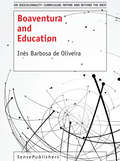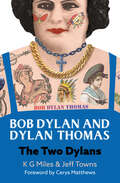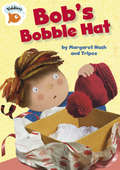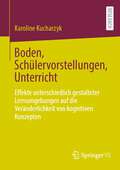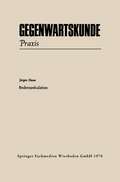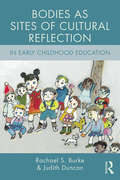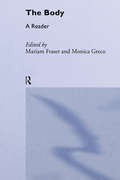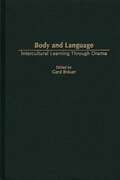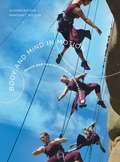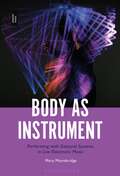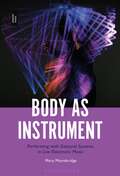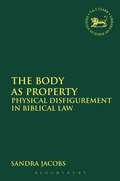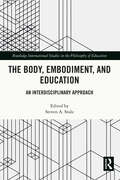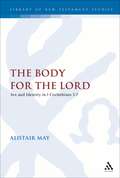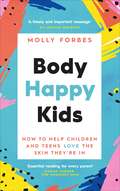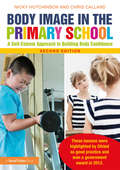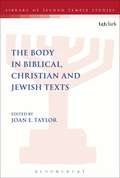- Table View
- List View
The Boat Star: A Story about Loss (Nurturing Emotional Resilience Storybooks)
by Juliette TtofaThe Boat Star is a therapeutic story about dealing with a painful loss and taking comfort in good memories. In this poignant story, a boy loses a special feather and goes on a magical journey to try to recover it. Although he doesn’t find his feather, he is comforted by the memory of the feather and realises he will feel better over time. This beautifully illustrated storybook will appeal to all children, and can be used by practitioners, educators and parents as a tool to discuss bereavement and coming to terms with feelings of loss with children. This story can be purchased alongside six other storybooks as part of a set (ISBN: 9781138556478), as well as in a set alongside the guidebook Nurturing Emotional Resilience in Vulnerable Children and Young People and six other storybooks (9781138556454). The guidebook outlines ways to use these beautifully told and visually appealing stories to nurture emotional resilience with children and will be invaluable tools for anyone working to build emotional resilience with children and young people.
Boaventura and Education (On (de)coloniality: Curriculum, within and beyond the west)
by Inês Barbosa de OliveiraThis book examines the work of the leading critical and decolonial intellectual Boaventura de Sousa Santos and its impact on education in general, and curriculum in particular. The volume brings to the table crucial itinerant theoretical rivers of thought in order to examine and understand the crises of modernity and their consequences. The author insightfully articulates Sousa Santos’ major arguments – ‘prudent knowledge’, ‘decent life’, ‘sociology of absences’, and ‘epistemicide’, among others – to unpack some of the major issues facing the contemporary critical terrain. In so doing, she examines how Sousa Santos retools the critical ‘emancipatory educational project’ towards a more just and participatory democratic society. “Boaventura de Sousa Santos’ groundbreaking theories on epistemology, politics, and society are weaved into brilliant focus against the backdrop of educational practice. What emerges is a powerful exposé of political tensions, contestations, and ruptures, inherent to the struggle against the persistent colonizing forces in the lives of oppressed populations. Central to this decolonizing treatise are the paradigmatic transformations essential to an education truly in the service of democratic life.” – Antonia Darder, Leavey Endowed Chair of Ethics & Moral Leadership, Loyola Marymount University, Los Angeles, Distinguished Visiting Professor of Education, University of Johannesburg, South Africa “A must read for educators and for students. Boaventura and Education allows one to understand the importance of the work of Boaventura de Sousa Santos that is essential for those who struggle for another world; that is more just, democratic, and united.” – Jurjo Torres Santomé, Professor, Universidade de A Coruña, Spain “In her work of art, precision, and clarity on the work of Boaventura, Inês Barbosa de Oliveira offers us a new framework with which to analyze and critically understand education. … Oliveira’s Boaventura and Education is a fundamental tool for thinking critically for all those who oppose the mental paralysis that harasses us.” – José Félix Angulo Rasco, Professor of Education, University of Cadiz, Spain, Professor of Education, Universidad Católica de Valparaíso, Chile
Bob Dylan and Dylan Thomas: The Two Dylans
by Jeff Towns K G MilesThere are so many strange and wonderful connections and coincidences; shared passions and associations that tie these two cultural icons – BOB DYLAN and DYLAN THOMAS together.This provides a rich tapestry – from the ancient Welsh folk tales of the Mabinogion to the poems of the Beat Generation; from Stravinsky to John Cale; from Johnny Ray to Charlie Chaplain. Rimbaud and Lorca, Sgt Pepper and The Bells of Rhymney, Nelson Algren and Tennessee Williams and much more. And the wonderful connections between authors K G Miles and Jeff Towns makes it the perfect partnership to write this book.Fifty-two years ago, author Jeff Towns opened his first bookstore in Swansea – he called it Dylans Bookshop – a youthful homage to the poet Dylan Thomas born and raised in Swansea, an author he admired. Eight years before that, in 1962, (when he had never really heard of Dylan Thomas), he had bought his first ever LP record, Bob Dylan's first ever LP release calledBob Dylanwith a track list; In My Time of Dyin', Fixin' to Die, See That My Grave is Kept Clean and so on; baker's dozen of powerful songs. Jeff read that his new hero had been born Robert Zimmerman but had changed his name to BOB DYLAN, a homage to a Welsh poet named DYLAN THOMAS.From that moment on THE TWO DYLANS became a constant part of and backdrop to his life. And the two Dylans kept on giving – they were both on the cover of the Beatles Sgt Pepper album. Peter Blake who fashioned the cover of Pepper, was a huge fan on Dylan Thomas' radio play Under Milk Wood. Jeff went to see Peter, they became friends and still are. Peter gave permission to use his wonderfulTiny Tina the Tattooed Lady©Peter Blake image for the cover of this book.London co-author K G Miles has been inspired by BOB DYLAN since being an awestruck child at Bob's Isle of Wight Festival in 1969. He is now the co-curator the of theDylan Room at London's Troubadour Cluband was honoured to address the inaugural conference at the Tulsa Archive in 2019.
BOBBY BAINS PLAYS A BLINDER
by Bali Rai Illustrated by Daniel DuncanA young Sikh footballer reaches out across the generational divide to help a lonely old man in an uplifting story from acclaimed author Bali Rai. When he spots a lonely old man watching his football games in the park, and then sees him again eating at the local gurdwara kitchen, Bobby wants to help. At first the man doesn't seem very friendly and he doesn't want to take part in the local walking football league for older people that Bobby tells him about. But when Bobby eventually changes his mind, it turns out that the man is a talented former professional footballer who has recently been widowed, and Bobby's invitation opens up a rewarding new opportunity for him to make connections in his local community.
Bob's Bobble Hat (Tiddlers #23)
by Margaret NashBob gets a new bobble hat! He does not like the bobble, but maybe someone else in the family will?The Tiddlers series features fun stories with a word count of fewer than 50 words for children who are just starting to read.A word list at the beginning of the story allows for a quick check of the reader's ability to read and understand words before reading, and a puzzle at the end of the story encourages rereading for pleasure
Boden, Schülervorstellungen, Unterricht: Effekte unterschiedlich gestalteter Lernumgebungen auf die Veränderlichkeit von kognitiven Konzepten
by Karoline KucharzykWährend es in der Schülervorstellungsforschung viele Studien zu spezifischen Themen entlang des Modells der Didaktischen Rekonstruktion gibt, fehlen vergleichende Wirksamkeitsstudien mit anderen definierten Unterrichtskonzepten in realistischen Lernumgebungen. In diesem Buch wird eine groß angelegte Wirksamkeitsstudie zwischen vorstellungsbasiertem Lernen und traditionellem Lernen im Geographieunterricht in der Doppeljahrgangsstufe 9/10 durchgeführt. Die Intervention ist eine Unterrichtsreihe, bestehend aus acht aufeinanderfolgenden Schulstunden. Unter der Leitfrage, ob durch die Berücksichtigung von vorstellungsbasiertem Lernen ein höherer Lernerfolg gegenüber einem traditionellen Vorgehen nach Abschluss einer Unterrichtseihe erzielt wird, dient eine Unterrichtsreihe zum Bodenschutz der Studie als inhaltlicher Rahmen. Als Untersuchungsdesign wird ein Pre-Post-Design mit Follow-Up-Testung nach einem halben Jahr genutzt, um die kurzfristige Lernleistung, die langfristige Behaltensleistung und den Behaltensverlust in fünf Lerngruppen (n=102) zu messen.
Bodies as Sites of Cultural Reflection in Early Childhood Education (Changing Images of Early Childhood)
by Rachael S. Burke Judith DuncanTaking the body as a locus for discussion, Rachael S. Burke and Judith Duncan argue not only that implicit cultural practices shape most of the interactions taking place in early childhood curricula and pedagogy but that many of these practices often go unnoticed or unrecognized as being pedagogy. Current scholars, inspired by Foucault, acknowledge that the body is socially and culturally produced and historically situated—it is simultaneously a part of nature and society as well as a representation of the way that nature and society can be conceived. Every natural symbol originating from the body contains and conveys a social meaning, and every culture selects its own meaning from the myriad of potential body symbolisms. Bodies as Sites of Cultural Reflection in Early Childhood Education uses empirical examples from qualitative fieldwork conducted in New Zealand and Japan to explore these theories and discuss the ways in which children’s bodies represent a central focus in teachers’ pedagogical discussions and create contexts for the embodiment of children’s experiences in the early years.
Bodies as Sites of Cultural Reflection in Early Childhood Education (Changing Images of Early Childhood)
by Rachael S. Burke Judith DuncanTaking the body as a locus for discussion, Rachael S. Burke and Judith Duncan argue not only that implicit cultural practices shape most of the interactions taking place in early childhood curricula and pedagogy but that many of these practices often go unnoticed or unrecognized as being pedagogy. Current scholars, inspired by Foucault, acknowledge that the body is socially and culturally produced and historically situated—it is simultaneously a part of nature and society as well as a representation of the way that nature and society can be conceived. Every natural symbol originating from the body contains and conveys a social meaning, and every culture selects its own meaning from the myriad of potential body symbolisms. Bodies as Sites of Cultural Reflection in Early Childhood Education uses empirical examples from qualitative fieldwork conducted in New Zealand and Japan to explore these theories and discuss the ways in which children’s bodies represent a central focus in teachers’ pedagogical discussions and create contexts for the embodiment of children’s experiences in the early years.
The Body: A Reader (Routledge Student Readers)
by Mariam FraserThe body has become an increasingly significant concept in recent years and this Reader offers a stimulating overview of the main topics, perspectives and theories surrounding the issue. This broad consideration of the body presents an engagement with a range of social concerns, from the processes of racialization to the vagaries of fashion and performance art, enacted as surgery on the body. Individual sections cover issues such as:the body and social (dis)orderbodies and identitiesbodily normsbodies in health and dis-easebodies and technologies.Containing an extensive critical introduction, contributions from key figures such as Butler, Sedgwick, Martin Scheper-Huges, Haraway and Gilroy, and a series of introductions summarizing each section, this Reader offers students a valuable practical guide and a thorough grounding in the fascinating topic of the body.
The Body: A Reader (Routledge Student Readers)
by Mariam Fraser Monica GrecoThe body has become an increasingly significant concept in recent years and this Reader offers a stimulating overview of the main topics, perspectives and theories surrounding the issue. This broad consideration of the body presents an engagement with a range of social concerns, from the processes of racialization to the vagaries of fashion and performance art, enacted as surgery on the body. Individual sections cover issues such as:the body and social (dis)orderbodies and identitiesbodily normsbodies in health and dis-easebodies and technologies.Containing an extensive critical introduction, contributions from key figures such as Butler, Sedgwick, Martin Scheper-Huges, Haraway and Gilroy, and a series of introductions summarizing each section, this Reader offers students a valuable practical guide and a thorough grounding in the fascinating topic of the body.
Body and Force in Music: Metaphoric Constructions in Music Psychology (SEMPRE Studies in The Psychology of Music)
by Youn KimOur understanding of music is inherently metaphorical, and metaphoricity pervades all sorts of musical discourses, be they theoretical, analytical, philosophical, pedagogical, or even scientific. The notions of "body" and "force" are the two most pervasive and comprehensive scientific metaphors in musical discourse. Throughout various intertwined contexts in history, the body–force pair manifests multiple layers of ideological frameworks and permits the conceptualization of music in a variety of ways. Youn Kim investigates these concepts of body and force in the emerging field of music psychology in the late nineteenth and early twentieth centuries. The field’s discursive space spans diverse contexts, including psychological theories of auditory perception and cognition, pedagogical theories on the performer’s bodily mechanism, speculative and practical theories of musical rhythm, and aesthetical discussion of the power of music. This investigation of body and force aims to illuminate not just the past scene of music psychology but also the notions of music that are being constructed at present.
Body and Force in Music: Metaphoric Constructions in Music Psychology (SEMPRE Studies in The Psychology of Music)
by Youn KimOur understanding of music is inherently metaphorical, and metaphoricity pervades all sorts of musical discourses, be they theoretical, analytical, philosophical, pedagogical, or even scientific. The notions of "body" and "force" are the two most pervasive and comprehensive scientific metaphors in musical discourse. Throughout various intertwined contexts in history, the body–force pair manifests multiple layers of ideological frameworks and permits the conceptualization of music in a variety of ways. Youn Kim investigates these concepts of body and force in the emerging field of music psychology in the late nineteenth and early twentieth centuries. The field’s discursive space spans diverse contexts, including psychological theories of auditory perception and cognition, pedagogical theories on the performer’s bodily mechanism, speculative and practical theories of musical rhythm, and aesthetical discussion of the power of music. This investigation of body and force aims to illuminate not just the past scene of music psychology but also the notions of music that are being constructed at present.
Body and Language: Intercultural Learning Through Drama (Advances in Foreign and Second Language Pedagogy)
by Gerd BräuerHighlights the bridging character of drama-based foreign and second language teaching for intercultural learning. Drama here is not limited to theater-related work, but means the interplay between body and language in general, to include, for example, sports, dancing, singing, and storytelling. The major techniques and curricular structures of educational drama and its application in the foreign and second language classroom are introduced.What are the techniques, methods, strategies, and curricular structures that engage language learners in continuing dialogue between one's own culture and the one yet to be discovered? What comprises the language we speak in order to understand and be understood? Which body is it we communicate through and to? This volume answers these and other questions of the pedagogy of drama-based teaching across the foreign/second language curriculum and on all levels of the educational pyramid.There are two major issues currently discussed in drama-based foreign and second language methodology. The first is goal-oriented, asking whether the acquisition of accuracy or fluency is more important, and whether a controlled (learning through imitation) or an open (through improvisation) learning environment is more efficient. The second issue concerns using drama in language teaching: either its use is process-oriented, where drama becomes an immediate medium for language learning, or product-oriented, where it becomes primarily the reason for language learning. The book outlines the theoretical frameworks of both issues and introduces personal narrative, comparative observation, and analytical reflection, illuminating opportunities for learning at both ends of the seemingly contradictory poles of both issues.
Body and Mind in Motion: Dance and Neuroscience in Conversation (PDF)
by Glenna Batson Margaret WilsonDrawing from the burgeoning field of 'embodiment' – itself an idea at the intersection of the sciences, humanities, arts and technologies – Body and Mind in Motion highlights the relevance of somatic education within dance education, dance science and body-mind studies.
Body as Instrument: Performing with Gestural Systems in Live Electronic Music
by Mary MainsbridgeBody as Instrument explores how musicians interact with movement-controlled performance systems, producing sounds imbued with their individual physical signature. Using motion tracking technology, performers can translate physical actions into sonic processes, creating or adapting novel gestural systems that transcend the structures and constraints of conventional musical instruments. Interviews with influential artists in the field, Laetitia Sonami, Atau Tanaka, Pamela Z, Julie Wilson-Bokowiec, Lauren Sarah Hayes, Mark Coniglio, Garth Paine and The Bent Leather Band expose the transformational impact of motion sensors on musicians' body awareness and abilities. Coupled with reflection on author-composed works, the book analyses how the body as instrument metaphor informs relationships between performers, their bodies and self-designed instruments. It also examines the role of experiential design strategies in developing robust and nuanced gestural systems that mirror a performer's movement habits, preferences and skills, inspiring new physical forms of musical communication and diverse musical repertoire.
Body as Instrument: Performing with Gestural Systems in Live Electronic Music
by Mary MainsbridgeBody as Instrument explores how musicians interact with movement-controlled performance systems, producing sounds imbued with their individual physical signature. Using motion tracking technology, performers can translate physical actions into sonic processes, creating or adapting novel gestural systems that transcend the structures and constraints of conventional musical instruments. Interviews with influential artists in the field, Laetitia Sonami, Atau Tanaka, Pamela Z, Julie Wilson-Bokowiec, Lauren Sarah Hayes, Mark Coniglio, Garth Paine and The Bent Leather Band expose the transformational impact of motion sensors on musicians' body awareness and abilities. Coupled with reflection on author-composed works, the book analyses how the body as instrument metaphor informs relationships between performers, their bodies and self-designed instruments. It also examines the role of experiential design strategies in developing robust and nuanced gestural systems that mirror a performer's movement habits, preferences and skills, inspiring new physical forms of musical communication and diverse musical repertoire.
The Body as Property: Physical Disfigurement in Biblical Law (The Library of Hebrew Bible/Old Testament Studies #582)
by Sandra JacobsThe Body As Property indicates that physical disfigurement functioned in biblical law to verify legal property acquisition, when changes in the status of dependents were formalized. It is based on the reality the cuneiform script, in particular, was developed in Sumer and Mesopotamia for the purpose of record keeping: to provide legal proof of ownership where the inscription of a tablet evidenced the sale, or transfer, of property. Legitimate property acquisition was as important in biblical law, where physical disfigurements marked dependents, in a similar way that the veil or the head covering identified a wife or concubine in ancient Assyrian and Judean societies. This is primarily substantiated in the accounts of prescriptive disfigurements: namely circumcision and the piercing of a slave's ear, both of which were required only when a son, or slave, was acquired permanently. It is further argued that legal entitlement was relevant also to the punitive disfigurements recorded in Exodus 21:22-24, and Deuteronomy 25:11-12, where the physical violation of women was of concern solely as an infringement of male property rights.
The Body, Embodiment, and Education: An Interdisciplinary Approach (Routledge International Studies in the Philosophy of Education)
by Steven A. StolzNotions of the body and embodiment have become prominent across a number of established discipline areas, like philosophy, sociology, and psychology. While there has been a paradigmatic shift towards this topic, there is a notable gap in the literature as it relates to education and educational research. The Body, Embodiment and Education addresses the gap between embodiment and education by exploring conceptualisations of the body and embodiment from interdisciplinary perspectives. With contributions from international experts in philosophy, sociology, and psychology, as well as emerging areas in related fields, such as embodied cognition, neuroscience, cognitive science, this book sets a new research agenda in education and educational research. Each chapter makes a case for expanding the field and adds to the call for further exploration. The Body, Embodiment and Education will be of great interest to academics, researchers and postgraduate students who are interested in the body and embodiment and/or its relationship with education or educational research.
The Body, Embodiment, and Education: An Interdisciplinary Approach (Routledge International Studies in the Philosophy of Education)
by Steven A. StolzNotions of the body and embodiment have become prominent across a number of established discipline areas, like philosophy, sociology, and psychology. While there has been a paradigmatic shift towards this topic, there is a notable gap in the literature as it relates to education and educational research. The Body, Embodiment and Education addresses the gap between embodiment and education by exploring conceptualisations of the body and embodiment from interdisciplinary perspectives. With contributions from international experts in philosophy, sociology, and psychology, as well as emerging areas in related fields, such as embodied cognition, neuroscience, cognitive science, this book sets a new research agenda in education and educational research. Each chapter makes a case for expanding the field and adds to the call for further exploration. The Body, Embodiment and Education will be of great interest to academics, researchers and postgraduate students who are interested in the body and embodiment and/or its relationship with education or educational research.
The Body for the Lord: Sex and Identity in 1 Corinthians 5-7 (The Library of New Testament Studies #278)
by Alistair MayAlistair May explores the part played by sexual ethics and the rhetoric of sexual morality in the formation of Christian identity by focusing on the longest discussion of sex in the New Testament - 1Corinthians 5-7. Viewing this passage as a unified discourse, he considers how Paul's ethics serve to give his converts a distinct identity. Although tools from the social sciences are used, the major focus of the work is in careful exegesis of the text. As the study progresses through the text of 1Corinthians 5-7, May argues that Paul strives to maintain an absolute distinction between insider and outsider in regard to morality. Immorality belongs exclusively to the outside and to the pre-conversion identity of the Corinthians. Hence those labelled immoral can no longer remain in the community. 1 Corinthians 6.12-20 reveals that, for Paul, sexual sin is unique in its destruction of Christian identity and that any sexual participation is a potential conflict with participation in Christ. Thus, chapter 6 is directly connected with the discussion of the legitimacy of marriage in 1Corinthians 7. Rejecting the scholarly consensus that Paul is reacting to ascetics, May controversially argues that chapter 7 should be read as Paul's commendation of singleness to a reluctant Corinthian audience.This is volume 278 in the Journal for the Study of the New Testament Supplement series.
Body Happy Kids: How to help children and teens love the skin they’re in
by Molly ForbesWe are not born hating our bodies. Make sure your kids never do.No parent wants their child to grow up with anything less than wholehearted confidence in themselves. Sadly research shows that children as young as five are saying they need to 'go on a diet' and over half of 11 to 16-year-olds regularly worry about the way they look. Campaigner and mum-of-two-girls Molly Forbes is here to help.In Body Happy Kids, Molly draws on her own experience and a range of experts to provide parents with a much-needed antidote to the confusing health advice that bombards us every day. This reassuring and practical guide covers everything you need to help your child to care for their body with kindness, including how to approach good nutrition (without falling for diet culture), how to see the reality behind beauty ideals and how social media can be used to support body confidence rather than destroy it. With Molly's help, you can arm yourself with the insight and tools to raise resilient children who love the skin they're in.
Body Image in the Primary School: A Self-Esteem Approach to Building Body Confidence
by Nicky Hutchinson Chris Calland80% of primary aged children have been on a diet. 75% of 10- to 11-year-olds would like to change their appearance. Children as young as 6 are worrying about their shape and size. Body image is an important aspect of children’s self-esteem and confidence. Unfortunately, many young children are suffering from anxieties about their appearance, which has a harmful effect on their overall mental health and wellbeing. This updated second edition of the award-winning Body Image in the Primary School recognises these anxieties as a concern for younger children that needs to be addressed at an early age, and examines some of the pressures that young people face. Presenting a clear, easy-to-use scheme of work to support emotional literacy and Personal, Social, Health and Economic Education (PSHE), throughout the primary school and into the first years of secondary school, this new edition offers: A practical evidence based curriculum for children aged 4 –13. More than 60 lively, varied and detailed lesson plans. Additional lessons on gender, social media and the selfie culture. An overview of research on the links between body image, academic achievement and emotional wellbeing. The evidence-based lessons in Body Image in the Primary School have been awarded the quality kitemark by the PSHE Association and highlighted by Ofsted as an example of excellent practice. This book will be of significant interest to all teachers, teaching assistants and practitioners working with primary aged children.
Body Image in the Primary School: A Self-Esteem Approach to Building Body Confidence
by Nicky Hutchinson Chris Calland80% of primary aged children have been on a diet. 75% of 10- to 11-year-olds would like to change their appearance. Children as young as 6 are worrying about their shape and size. Body image is an important aspect of children’s self-esteem and confidence. Unfortunately, many young children are suffering from anxieties about their appearance, which has a harmful effect on their overall mental health and wellbeing. This updated second edition of the award-winning Body Image in the Primary School recognises these anxieties as a concern for younger children that needs to be addressed at an early age, and examines some of the pressures that young people face. Presenting a clear, easy-to-use scheme of work to support emotional literacy and Personal, Social, Health and Economic Education (PSHE), throughout the primary school and into the first years of secondary school, this new edition offers: A practical evidence based curriculum for children aged 4 –13. More than 60 lively, varied and detailed lesson plans. Additional lessons on gender, social media and the selfie culture. An overview of research on the links between body image, academic achievement and emotional wellbeing. The evidence-based lessons in Body Image in the Primary School have been awarded the quality kitemark by the PSHE Association and highlighted by Ofsted as an example of excellent practice. This book will be of significant interest to all teachers, teaching assistants and practitioners working with primary aged children.
The Body in Biblical, Christian and Jewish Texts (The Library of Second Temple Studies #85)
by Joan E. TaylorThe body is an entity on which religious ideology is printed. Thus it is frequently a subject of interest, anxiety, prescription and regulation in both the Hebrew Bible and the New Testament, as well as in early Christian and Jewish writings. Issues such as the body's age, purity, sickness, ability, gender, sexual actions, marking, clothing, modesty or placement can revolve around what the body is and is not supposed to be or do. The Body in Biblical, Christian and Jewish Texts comprises a range of inter-disciplinary and creative explorations of the body as it is described and defined in religious literature, with chapters largely written by new scholars with fresh perspectives. This is a subject with wide and important repercussions in diverse cultural contexts today.

